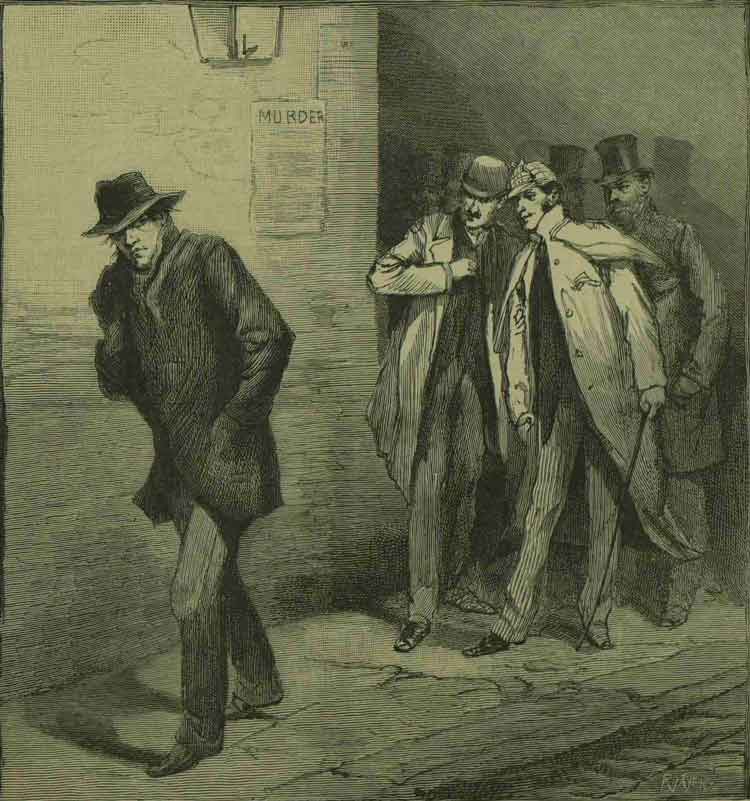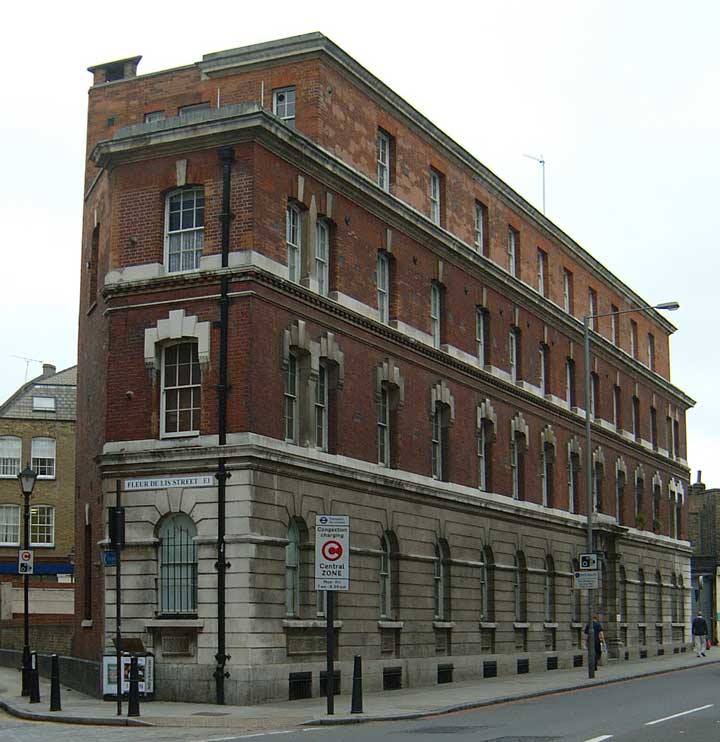By the second week of October, 1888, the murders of Elizabeth Stride and Catherine Eddowes, both of which had occurred within an hour of each other in the early hours of Sunday the 30th of September, had put the East End of London into a state of extreme terror and excitement.
Over the two weeks that followed the murders, not only did the police presence in the district increase considerably, but the vigilance patrols also stepped up their activities in the district, desperate to prevent another outrage occurring.
The Western Times, in its edition of Tuesday the 9th of October 1888, provided its readers with an insight into the activity in the area and gave them an idea of the impact that the fear of the unknown miscreant was having on the people who lived there:-
SATURDAY NIGHT’S PRECAUTIONS
Throughout Saturday the inhabitants of Whitechapel were kept in a state of feverish excitement by the knowledge that threatening letters were constantly being received by the police authorities at the various stations intimating that the assassin would shortly recommence his ghastly work.
Towards the evening the dismay became remarkably intensified, as reports of further threats were circulated, many of them appearing to be the pure inventions of cruel triflers.
But whether true or false, they at least served as an incentive not only to the police to adopt extra precautions, but even stimulated the residents to, if possible, prevent a repetition of the horrible murders.

THE STREETS WERE DESERTED
Soon after ten o’clock the streets of Whitechapel and Spitalfields assumed an almost deserted appearance as far as women were concerned, and those who ventured abroad did not do so singly, but moved about in twos and threes.
Even the unfortunate class were not an exception to this rule.
This plan seems to have been adopted by women of this character, and doubtless will prove a great obstacle to the movements of the murderer, who, knowing that a third party haunts his actions, will not find another opportunity so easily of carrying out his designs.
EXTRAORDINARY PRECAUTIONS
The police were nervously apprehensive that the night would not pass without some startling occurrence.
The most extraordinary precautions were taken in consequence, and so complete were the measures adopted, both by the City and Metropolitan Police authorities, that it seemed impossible for the murderer to make his appearance in the East End without detection.
Large bodies of plain-clothes men were drafted by Sir Charles Warren to the Whitechapel district from other parts of London, and these, together with the detectives, were so numerous that in the more deserted thoroughfares almost every man met with was a police-officer.
THE CITY OF LONDON POLICE
The City Police, far from being outdone in their exertions to ensure the protection of the public, more than doubled the patrols, so that almost every nook and corner of the various beats came under police supervision every five minutes.
In addition to this measure, men were stationed at fixed distances to watch for any suspicious looking persons, and, when thought at all necessary, to follow them.
ALL LONDON WAS ON ALERT
These arrangements to ensure safety and to reassure the public of the efforts taken on their behalf applied equally to other parts of the metropolis, it being thought that the murderer finding Whitechapel rather too warm for him might transfer his operations to another district.
The parks, where the fiend would have no difficulty in finding victims, were specially well patrolled, and the police in the most outlying districts were keenly alive to the anxieties of the situation.
Most of the men were on duty all Friday night in the East End; the extra work, therefore, was particularly harassing.
But every man entered heartily into the work, and not a murmur was heard.
All were upon their mettle, and if collective and individual zeal were all that was required, the murderer would soon be hunted down.
THE PEOPLE WERE STEPPING UP
Supplementing the energy displayed by the police, hundreds of people living in the back streets sat up all night, whilst dozens of sturdy householders paid occasional visits to yards and other secluded spots in their immediate vicinity.
The volunteer patrols organised by the Whitechapel Vigilance Committee lent marked assistance to the police.
Their patrols were told off to well planned beats, many of these amateur policemen being furnished with noiseless boots, a measure which has lately been strongly urged upon the Metropolitan Police.
HE MIGHT SHOOT THEM
It is supposed that the murderer is armed with a revolver, and, if detected, will shoot at the first person who attempted to capture him: in any case his knife, in such skillful hands, would, if he had the slightest chance of dealing a blow, prove mortal.
The large reward offered has, however, afforded sufficient stimulus to as large a number of strong, able-bodied men as are required for the dangerous duty of tracking down the murderer.
LETTERS AND A TELEGRAM FROM JACK THE RIPPER
The Eastern Daily Press, on Monday the 8th of October, 1888, published details of how some members of the public were hindering rather than helping the attempts to apprehend the perpetrator, and how some were even exacerbating the fear and unease by imitating the killer:-
The police continue to receive many descriptions of men who are supposed to answer the published particulars, but few cases warrant an arrest.
Amongst others, for instance, was one given at Bishopsgate Police Station of a man who went aboard the City of London at 9.45 on Saturday morning, and asked for the steward.
He then inquired if there were any females on board, stating that knew there were, as he could smell them.
He then left in hackney carriage for Camden Station.
The man is described as about forty years of age, 5ft. 9in. in height, complexion fair, and moustache dark, wearing a blue serge suit, lace boots, and a black felt hat.
THE MATCH GIRLS THREATENED
Intimation was also given to the City Police on Saturday morning that Messrs. Bryant and May had received a letter from a person signing himself J. Ripper, couched in the following terms:-
“I hereby notify that I am going to pay your girls visit. I hear that they are beginning to say what they will do with me…… (Signed) John Ripper. P.S. I am in Poplar today.”
A LETTER TO THE POLICE
The following postal telegram was received by the Metropolitan Police at 11.55 p.m. on Friday night.
It was handed in at an office in the Eastern District at 8 p.m.:-
“Charles Warren head of the the Police News Central Office.
Dr. Boss. If you are willing enough to catch me I am now in the City Road lodging, but number you will have to find out, and I mean to do another murder tonight in Whitechapel.
Yours Jack the Ripper.”
COMMERCIAL STREET POLICE STATION LETTER
A letter was also received at the Commercial Street Police Station by first post on Saturday morning.
It was addressed to the “Commercial Street Police-station” in black lead pencil, and the contents, which were also written in pencil, were couched in ridiculous language, the police believing it to be the work of a lunatic.
It was signed “Jack the Ripper,” and said that he was “going work” in Whitechapel on Saturday night.
He added that he was going to commit another murder in the Goswell Road, and spoke of having “several bottles of blood under ground in Epping Forest,” and frequently referred to “Jack the Ripper under the ground.”

ABSURD INFORMATION
As an example of the vast amount of absurd “information” which is imparted to the police, and through which they have to wade, a man called at the Commercial Street Police Station, stating that he thought he had a clue.
Upon inquiry it was ascertained that he knew a man who cut a baby to pieces twenty years ago and afterwards escaped to America, it being his impression that the baby mutilator might have returned and committed the recent horrible mutilations.
In that case, he said, he could give a description.
JACK THE RIPPER IN BIRMINGHAM
Meanwhile, in Birmingham, according to The Shields Daily Gazette on Saturday the 6th of October 1888, a man from London had been making a decided nuisance of himself in a pub:-
At Birmingham Police Court today, a man, giving the name of Alfred Napier Blanchard, a canvasser from London, was charged, on his own confession, with the Whitechapel murders.
The prisoner was arrested on the strength of a statement he had been making in a public-house, a continuing circumstantial account of his proceedings.
He now denies any connection, and explains his confession by pleading mental excitement caused by reading about the affair.
He was remanded till Monday, but the police do not consider the arrest important.
THE EXCITEMENT WOULD CONTINUE
There can be no doubt about it, the Whitechapel murders were of nationwide interest by October 1888; and the fact that an unknown letter-writer had now bestowed upon the perpetrator the sobriquet of Jack the Ripper, ensured that, from this point on, the crimes themselves would be relegated to almost a secondary role in a saga that was rapidly assuming pantomime status across the country.
However, the increased activity in the district itself appears to have deterred the killer, with the result that the whole of October would pass with no further murders, and, by early November the excitement, and terror had begun to abate as people began to think that the crime spree was over.
THE GIFT OF HINDSIGHT
Of course, with hindsight, we know that Jack the Ripper was merely biding his time.
He knew that the extra precautions would soon be relaxed and it wouldn’t be long before economic necessity would force another victim into his clutches.
And, on Friday the 9th of November, he struck again, and carried out his most gruesome and barbaric atrocity when he murdered Mary Kelly in her tiny room at 13 Miller’s Court.
